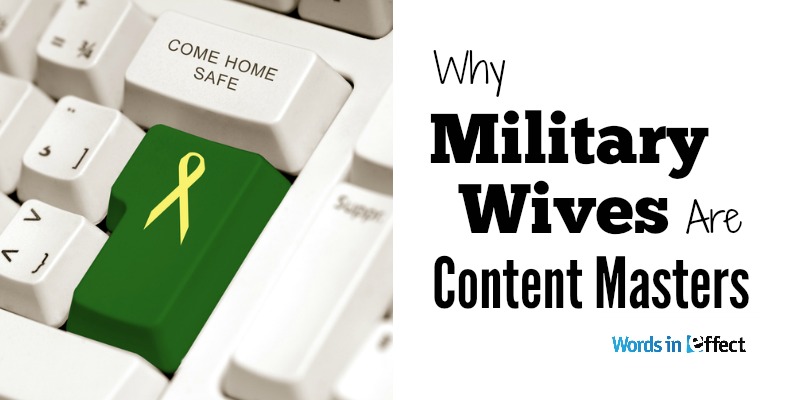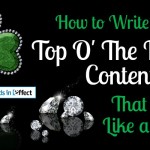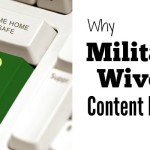
I’m a B2B content writer. I’m also the proud wife of an Army pilot.
For a long time, I saw these as two different hats I wear. Different arenas, different perspectives. Different lessons.
Boy, was I wrong.
I had this epiphany recently, a few days after my husband said goodbye to members of his battalion who were deploying to the Middle East. I’d been through two deployments myself—first, struggling to care for a newborn; later, with two young children under the age of 5.
Those two years apart were no picnic. Time stood still for our family. My best friend was gone—and in harm’s way. I had no alpha male around to calm and collect our two boys. Or me, for that matter.
But these separations also made me a stronger person. A better listener. And, as it turns out, a better content writer.
Here’s what I learned then, and how you can apply those lessons now.
Practical and Emotional Needs: A World Apart
Military wives left to defend the home front have two layers of need. Both layers are important. In some ways, they go hand in hand.
But they can’t be addressed the same way.
One of them requires a lot more dedication and finesse.
Your prospects’ needs are layered the same way. Understanding the difference, and why it matters, is what separates great content from the rest.
#1: Practical (Surface Level)
Day to day during the deployment, I had a variety of practical needs. Some cropped up suddenly, some were anticipated, and some were ongoing.
Who should I call to fix this leaky pipe?
Who will I enlist to mow our lawn? Trim our trees?
Who can help me with the kids now and then?
I needed to find qualified, reliable people for these jobs. But that was never a problem. I’d get a good recommendation from someone. Or work out an arrangement with a neighbor. Or research top-rated service providers.
I knew I had lots of people, places, and search engine results I could turn to for practical solutions.
When someone would say to me, “I know a guy,” I felt assured.
When the guy showed up and solved my problem, I thanked him and wrote him a check. I felt relieved.
But these interactions were like Snapchat conversations. My impressions and feelings were positive, but they were fleeting.
#2: Emotional (Deep-Seated)
Well below the surface lay the emotional needs. These included the need to be understood, supported, and encouraged.
Talk about “pain points.” The practical stuff doesn’t compare!
Military wives are expected to carry on with a brave face while their spouses serve overseas. But here’s what many of them experience out of sight.
Anxiety. Fear.
Isolation. Sadness.
Frustration. Boredom.
Feeling like a third wheel around intact families.
Concerned about appearing needy or weak.
These emotional needs are deep and complex. They color every interaction; they inform every decision.
Not many people are capable of meeting these needs. Even fewer are willing to invest the right amount of time, thought, and energy. But the ones who do offer the most value.
How? By demonstrating insanely high emotional intelligence (EQ).
Here’s what the high-EQ individuals in my life did for me:
- They took great interest in me, my family, and my state of mind.
- They didn’t yammer on about themselves in an insensitive way.
- They took the time to engage meaningfully, whether the setting was relaxed, fun, or serious.
- They acknowledged my pain, listened well, and showed genuine concern. They made me feel special and loved.
Needless to say, we grew closer. I got to know them better. I appreciated them more.
And I raved about them to anyone who would listen.
See where I’m going with all this?
Features vs. Benefits: No Contest
We humans like to think of ourselves as rational creatures. [ . . . ] But when you come down to it, emotion always wins.” —Sonia Simone, Copyblogger
Your prospects have real, practical problems. And they need information, resources, and/or products to solve them.
You can provide these things. So can most of your competitors. Your practical capability isn’t your biggest differentiator.
This is why surface-level content that centers on features and ignoresbenefits is neither engaging nor effective. It just adds to the content heap.
- It doesn’t draw meaningful distinctions.
- It’s gleefully detached from readers’ motivations and concerns.
- It’s tone deaf.
- It’s completely forgettable.
When you encounter this kind of content, does it resonate with you? Does it make you want to learn more about the company? Does it draw you further down the funnel?
Likely not.
Yes, the practical stuff is important. But it’s not the primary material you should use to build content.
In fact, stop hammering away. Lose the content factory mindset.
Be a nurturer. Build relationships instead.
Outstanding Content Drills Down, Aims Right for the Core
When you connect your know-how and enthusiasm to your client’s desires, the magic happens.” —Henneke Duistermaat, Enchanting Marketing
Outstanding content appeals to readers’ emotions. It addressesreal pain points—the stuff that complicates people’s lives or keeps them up at night.
When you sit down to write, don’t aim to impress; aim to inspire. Be authentic. Let your passion for service and your desire to connect light the way.
This is how standout content is built. It’s how fans, brand ambassadors, and customers are won.
Quantity, frequency, variety—these aren’t important. Only empathy matters.
So go forth, and make content that matters.

Since 2001, Becky Tumidolsky has written awareness-building content for B2B brands and their discerning audiences. Her work has appeared in leading publications such as Forbes, U.S.News & World Report, Bloomberg Markets, Newsweek, and Inc. as well as corporate blogs, websites, white papers, and other content assets.
Becky loves writing fluid, error-free prose. She’s even more passionate about building the foundation for her work—uncovering core brand distinctions, framing them thematically, and developing fresh, compelling narratives that advance corporate strategies.
Follow and connect: Twitter| Google+| LinkedIn| Facebook





Leave a Reply